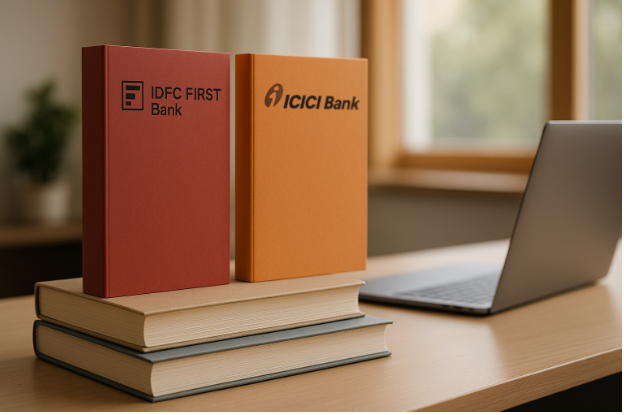Choosing between IDFC First Bank and ICICI Bank for an education loan? Here’s an insight which can help you decide.
IDFC First Bank vs ICICI Bank Education Loans: Comparison
When deciding between IDFC First Bank and ICICI Bank for an education loan, understanding their differences can help you make the right choice. Both banks cater to students planning to study abroad, but their loan terms, interest rates, and eligibility requirements differ in key ways.
Comparison Table
IDFC First Bank focuses on convenience with a longer moratorium period (course duration + 12 months) and no margin money requirement. On the other hand, ICICI Bank offers a shorter moratorium period (course duration + 6 months) but includes a work experience-based loan programme. This programme is available for professionals earning at least ₹35,000 per month and having a minimum of 2 years of work experience.
For those seeking collateral-free loans, IDFC First Bank's higher limit of ₹75 lakh provides more room compared to ICICI Bank's ₹40 lakh cap. These differences can help you determine which bank better suits your study abroad plans.
Next, we'll explore how these loans differ in terms of college acceptance and institute categories.
IDFC First Bank vs ICICI Bank: Detailed Comparison
Choosing the right education loan provider can make a big difference in your financial planning for overseas education. IDFC First Bank and ICICI Bank are top choices for Indian students, but how they assess your eligibility, set loan terms, and offer benefits can vary greatly. Here’s a simple breakdown of how each bank approaches the most important factors.
College Acceptance
When it comes to education loans, the type of institution you’re admitted to can play a huge role in determining your loan terms. Both IDFC First Bank and ICICI Bank maintain lists of pre-approved colleges, and these lists directly affect your loan eligibility, interest rates, and the maximum loan amount you can secure. If your chosen university isn’t on these lists, you might not qualify for a loan from these banks.
The ranking or category of your institution also impacts the terms of your loan. Generally, higher-ranked institutions come with better loan conditions - like lower interest rates and higher loan limits.
Institute Categories
ICICI Bank's A1–A4 Tier System
ICICI Bank organises universities into four tiers: A1, A2, A3, and A4, covering 750 approved universities in popular study destinations.
Premium Select Category: This includes top-tier institutions like Harvard University, University of Toronto, Imperial College Business School, and Trinity Business School. Students attending these universities can borrow up to ₹1 crore at interest rates starting from 11.25%, without needing a financial co-applicant.
Premium Category: This tier includes over 400 universities in countries like the US, UK, Germany, Australia, and Canada. Loans of up to ₹1 crore are available, but a financial co-applicant is mandatory.
Others Category: For institutions in this group, students can borrow up to ₹20 lakh, with interest rates starting at 11.75%. Margin money requirements range from 0% to 15%, depending on the institution's ranking.
IDFC First Bank's Platinum, Titanium, Gold Categories
IDFC First Bank uses a three-tier system - Platinum, Titanium, and Gold - along with an additional Bronze category. These classifications are based on factors like university rankings and job prospects for specific courses.
Platinum Category: This offers the most favourable terms. For instance, a Master of Data Science programme at The University of Adelaide falls under this category. Students can secure loans with options like non-financial co-applicants, full moratorium periods (no payments during the course and grace period), and flexible repayment plans such as PSI, SI, or EMI.
Gold Category: This comes with stricter terms. For example, MSc Management at Nottingham Trent University is classified under Gold. Here, a financial co-applicant earning at least ₹35,000 per month is mandatory, and repayment options during the moratorium are more limited.
For students pursuing MS programmes in Canada, IDFC First Bank’s Platinum category offers loans of ₹41 lakh at 11.75%, while the Gold category caps loans at ₹29 lakh with an interest rate of 13.25%. That 1.5% difference in interest rates can significantly impact your overall repayment.
It’s also important to note that processing fees vary by category. For Platinum and Titanium categories, IDFC First Bank charges 1% + GST, while the Gold category attracts a slightly higher fee of 1.25% + GST. These additional costs can add up and should be factored into your decision-making.
If your university isn’t on the pre-approved lists of these banks, you might need to look into alternative funding options or explore collateral-free loans from other providers.
Get Education Loan 10X Faster than Banks.
Maximum Loan Limits
Both banks provide secured loans up to ₹1 crore, but the distinction lies in their unsecured loan offerings.
IDFC First Bank allows collateral-free loans up to ₹75 lakh, significantly higher than ICICI Bank's limit of ₹40 lakh. This ₹35 lakh difference can be a game-changer for students pursuing costly programmes. For instance, if you're aiming for an MBA at a top US business school, where total expenses often range between ₹60–70 lakh, IDFC First Bank's higher limit could save you from arranging collateral. In contrast, with ICICI Bank, you’d need to provide collateral for any amount exceeding ₹40 lakh.
Collateral Requirements
Collateral requirements vary significantly between the two banks, especially for higher loan amounts.
ICICI Bank: Collateral is typically required for loans exceeding their unsecured limit. Accepted forms of collateral include residential property, fixed deposits, or even an existing ICICI Bank home loan. As the loan amount rises, the bank's collateral requirements become stricter.
IDFC First Bank: With unsecured loans available up to ₹75 lakh, this bank offers greater flexibility. Whether collateral is needed depends on factors like the loan amount, your institution's ranking on their approved list, and your overall profile, including co-applicant income and credit history. This approach is particularly helpful for families without access to large fixed deposits or property.
Interest Rate Comparison
Interest rates are another critical factor that can significantly affect the cost of borrowing.
ICICI Bank: Interest rates range from 9.85% to 15.5%, influenced by factors like the institution's tier, your GRE or GMAT scores, and the co-applicant's financial profile. ICICI Bank links rates to the Repo Rate, meaning they fluctuate with changes in RBI's monetary policy. For example, loans for A1 category institutions start at 10.85% for amounts up to ₹50 lakh, while A3 category loans up to ₹15 lakh attract rates of 12.25%.
IDFC First Bank: Their interest rates are more predictable, ranging from 11.5% to 12.25%. For instance, loans for Platinum category institutions are offered at 11.5% for amounts up to ₹50 lakh, while Gold category loans up to ₹30 lakh come with a 12.25% interest rate. Even a small difference, like 1.5% between categories, can lead to substantial savings over the loan term.
Additionally, both banks consider GRE or GMAT scores when determining interest rates. Higher scores, combined with admission to top-tier institutions, can help you secure better rates, especially with ICICI Bank. A co-applicant with a stable monthly income - typically above ₹35,000 - can further improve your chances of getting a lower rate from either bank.
For students exploring study abroad loan providers, understanding these nuances ensures you can compare options effectively and not just rely on advertised rates.
When comparing education loans, additional charges can significantly impact the overall cost of borrowing. Let’s dive into how IDFC First Bank and ICICI Bank differ in terms of processing fees, margin money, and other related charges.
Processing Fees and Charges
Processing fees are a crucial factor, especially for students managing tight budgets. IDFC First Bank stands out by waiving processing fees for loans up to ₹7.5 lakh. For higher loan amounts, they charge up to 1.5%. This is particularly advantageous for students seeking moderate funding.
On the other hand, ICICI Bank applies a flat processing fee of up to 2% across all loan sizes. For instance, on a ₹50 lakh loan, ICICI’s fee could go up to ₹1 lakh, whereas IDFC First Bank caps it at ₹75,000. This difference can make a noticeable impact on the total cost of the loan.
Margin Money Requirements
Margin money, which is the borrower’s own contribution towards the total loan amount, is another area where the two banks differ significantly. IDFC First Bank offers 100% financing for all its approved institutions, meaning no margin money is required. In contrast, ICICI Bank’s margin money requirements vary depending on the institution category:
A1 institutions: No margin money required.
A2 institutions: 5% margin money required.
A3/A4 institutions: 15% margin money required.
For example, if you’re enrolling in a ₹60 lakh programme at an A3 institution, ICICI Bank would require 15% margin money, amounting to ₹9 lakh. Meanwhile, IDFC First Bank would not require any upfront contribution. This can be a game-changer for students looking to minimise their initial financial burden.
Given that 7.5 lakh Indian students travelled abroad for higher education in 2022, reducing upfront costs like processing fees and margin money can make a significant difference in making education loans more accessible.
Minimal Docs, Maximum Approval - Apply Now
Special Features and Repayment Options
Both banks bring unique features to the table, shaping your education financing experience. Let’s dive into these special offerings and repayment options to help you make a well-informed choice.
IDFC First Bank – Work Experience-Based Education Loan
Purpose:
- Designed for working professionals pursuing MBA programs, certifications, or career-enhancing courses abroad or in India
- Covers tuition fees and related educational expenses, including travel, accommodation, and living expenses
Key Features:
- Flexible repayment options with loan tenure up to 15 years
- Collateral-free loans up to ₹50 lakhs; loans up to ₹75 lakhs with collateral, based on institution and course
Unique Advantage:
- Supports salaried professionals (e.g., software engineers earning ₹50,000/month) with work experience seeking to study abroad without heavy reliance on co-applicant income alone
- Provides education loans based on future income potential and work experience
ICICI Bank – Work Experience-Based Education Loan
Purpose: Tailored for working professionals pursuing MBA programmes, certifications, or career-enhancing courses abroad.
Key Feature: Requires a fixed deposit to cover the moratorium interest, reducing financial strain during the study period.
Unique Advantage:
- Ideal for professionals (e.g., software engineers earning ₹50,000/month) who wish to study abroad without relying on a co-applicant’s income.
- Considers both employment history and salary progression for income assessment.
- Exclusively offered by ICICI Bank.
Repayment Flexibility of ICICI Bank & IDFC First Bank
Moratorium Period:
- IDFC First Bank: Course duration + 12 months
- ICICI Bank: Course duration + 6 months
- Impact: For a 2-year Master’s programme, IDFC First Bank repayment begins 3 years later, ICICI Bank repayment starts in 2.5 years.
Prepayment Charges:
- Both Banks: No penalty for prepayment, enabling early clearance of the loan without extra cost.
Repayment Tenure:
- Both Banks: Up to 12 years repayment period for manageable EMIs, especially useful in the early career stage.
Insurance Requirement:
- IDFC First Bank: Mandatory loan insurance—adds to cost but ensures family financial security.
- ICICI Bank: Insurance optional—greater flexibility in managing costs.Additionally, both banks support SI (Standing Instructions) and PSI (Post-Dated Standing Instructions), ensuring flexible repayment methods to help you smoothly manage your education loan without collateral throughout the repayment period.
Which Bank Should You Choose?
The detailed comparison highlights clear differences between the two banks. Here’s how to decide based on your specific needs:
Go with IDFC First Bank if your priorities include:
Higher unsecured loan amounts: IDFC First Bank offers up to ₹75 lakh without collateral, compared to ₹40 lakh from ICICI Bank.
100% financing: No margin money is required, while ICICI Bank may ask for 0-15% depending on the college tier.
Longer moratorium period: You get an extended break of course duration plus 12 months, giving you more breathing room after graduation.
Lower co-applicant income requirement: IDFC First Bank accepts co-applicants with a minimum monthly income of ₹35,000, making it more accessible for families with modest earnings.
Choose ICICI Bank if you value:
Lower starting interest rates: If affordability is your focus, ICICI Bank offers rates starting at 10.50%.
Loans for working professionals: ICICI Bank provides loans tailored for individuals with 2+ years of work experience earning ₹35,000 or more monthly.
Better branch accessibility: With a wider network across India, ICICI Bank ensures easier access for loan servicing and support.
Lower processing fees: Starting at 0.5%, ICICI Bank’s fees can reduce your upfront costs, depending on your profile.
Additionally, consider how your college’s tier classification affects loan terms, as this can influence both the interest rate and the loan amount you qualify for.
Key Takeaways
- Choose IDFC First Bank if you need a higher unsecured loan, no margin money, or a longer repayment break.
- Opt for ICICI Bank if you prefer lower starting interest rates, better branch accessibility, or loans tailored for working professionals.
Both banks have distinct advantages, so your choice should align with your financial needs and study plans.













.svg)